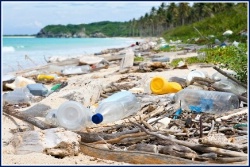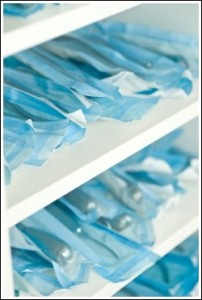The key to reducing our waste is to extend the life of the things we use.
Most people are familiar with the three R’s: Reduce, Re-use, Recycle. It’s common to think of Recycling as the first solution to handling our trash, but Reducing and Re-using are actually much more effective.
REDUCE
If we don’t create trash, it doesn’t have to be sent away somewhere. Packaging accounts for 33% of garbage. Many manufacturers are cutting down on the amount of packaging for their products, or making more of the packaging re-usable or recyclable. Many high-tech innovations in dentistry help reduce waste, like oral cancer diagnostics that create less waste than oral cancer rinse screenings.
Examples of Dental Office Opportunities to Reduce:
- Purchase often-used items in bulk: Prophy paste, gloves, masks, cotton squares
- Request supply companies combine orders to cut down on shipping boxes
- Set printers for double-sided printing
- Implement digital technology for imaging, impressions, cancer screening, charting, marketing
- Use steam sterilization eliminating the use of chemicals
RE-USE
Extending the life-cycle of an item by re-using it eliminates the need to transport it “away,” the need to store it as trash, and the need to create a new item. Single-use infection control items are the biggest source of trash in the dental office, sending billions of pieces of paper and plastic trash into the environment every year.
Paper and plastic pouches for sterilization, plastic chair barriers, plastic tray covers, plastic head rest covers are tossed by the hundreds every week in the typical dental practice. Much of this plastic waste can be reduced by switching to cloth infection control and sterilization, which has been used in high-end hospital operating rooms for decades.
By switching to re-usables, a typical single-dentist practice can divert as much as 4680 paper and plastic autoclave bags annually. By transitioning from the two-ply paper, one-ply plastic patient bibs to re-usable ones, a practice can divert as much as 40,800 pieces of paper and 20,400 pieces of plastic from landfill each year. Other plastic, single-use items can be replaced with stainless-steel ones that can be sterilized and re-used for years, like impression trays.
Examples of Dental Office Re-Usables:
- Switch to cloth sterilization bags & patient barriers
- Wear cloth lab coats instead of paper ones
- Use a re-usable face shield
- Re-use lab & shipping boxes
- Switch to stainless steel impression trays, suction tips
- Provide glass or ceramic “rinse & swish” cups
- Use washable dishes & cutlery in the staff break room
RECYCLE
Recycling should be our last resort, and we need to do a much better job recycling everything that we can. It’s estimated that 85% of the 26,000,000,000 water bottles the US uses each year are NOT recycled, and end up as garbage. Creating those bottles uses enough oil to fuel 100,000 cars. Recycling consumes energy to transport the item to the recycling center, and then to re-purpose it into a new use. Recycling costs about $50 per ton.
Examples of Dental Office Recyclables:
- Participate in an instrument recycling program that turns them into industrial metal
- Use a sharps disposal service that recycles them into building materials
- Recycle copy paper and choose a medical shredding service that recycles the shredded paper
- Provide recycling bins for staff break-room waste
RECYCLED vs. RECYCLABLE
As more consumers have become aware of their choice for how to handle waste, some companies have begun to place the “recyclable” label on their products. This is mis-leading as some consumers will think this means it’s better for the environment.
A “recyclable” item means it is entirely new, does not contain any recycled material, and simply has the potential to be recycled. For truly green products, look for the “recycled” material label, which will usually also state what percentage of the material is recycled content. For plastics, pay attention to the number on the bottom of the item. If it says number “1” it is recyclable in just about every American city. But few municipalities have the capability to recycle number “5” and “7” plastics and these items end up right back in the landfill forever.
 According to the Keep America Beautiful website, Americans generate 250 million tons of garbage per year, and since 1960, the amount of waste generated in the US has nearly tripled.
According to the Keep America Beautiful website, Americans generate 250 million tons of garbage per year, and since 1960, the amount of waste generated in the US has nearly tripled.
 Our single-use disposable ways require us to create a whole new item the next time we need that item. Creating new stuff every time we need it takes tremendous energy and natural resources.
Our single-use disposable ways require us to create a whole new item the next time we need that item. Creating new stuff every time we need it takes tremendous energy and natural resources.